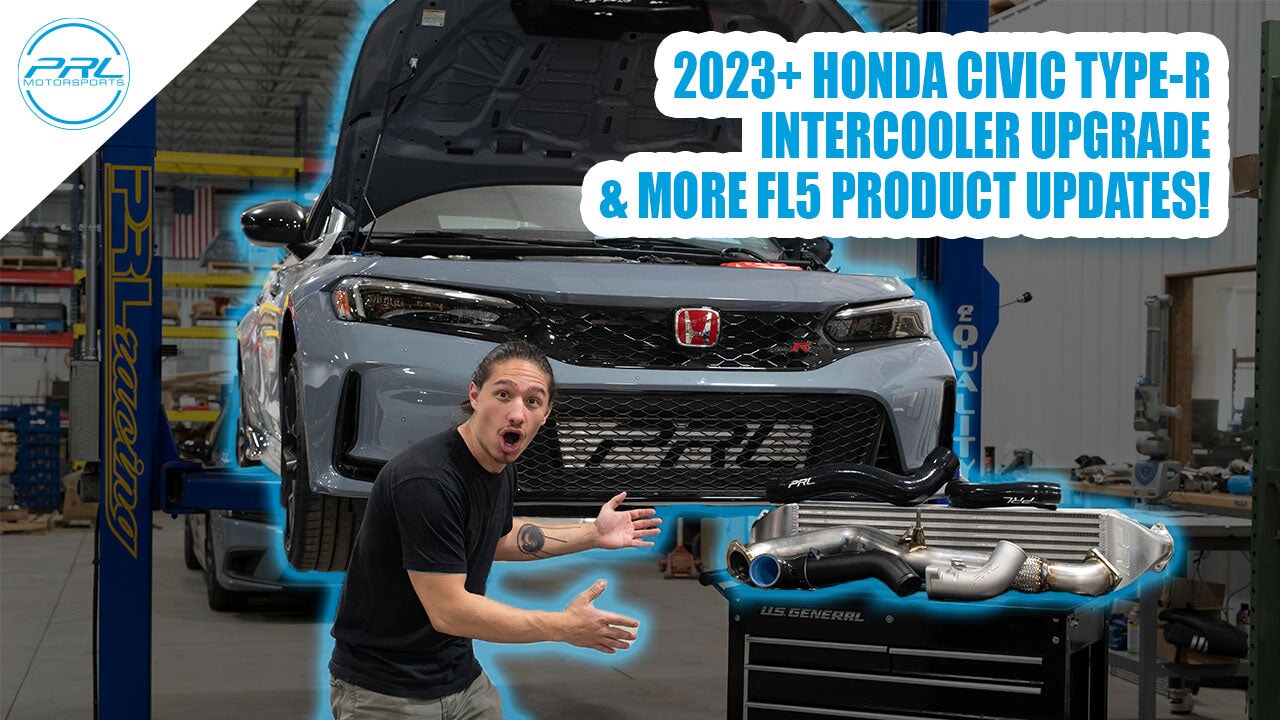Now that our prototype billet end tanks are complete and sample cores are in, we have decided put together a few functioning intercoolers to test that our design lived up to its expectations. Our engineers datalogged some street driving with our 2023 Honda Civic Type-R FL5 using both the factory and PRL Motorsports intercooler upgrade before heading to the dyno. The dyno session was started by taking a completely stock baseline run at an average temperature of 59°F and an elevation of 1160ft. Here’s what we found:



Once strapped to the dyno, we started out by doing a few power pulls, to establish a baseline for before and after installing our intercooler. All pulls were were done starting at 180 degrees coolant temp. With the factory setup, we saw a peak of 302WHP / 323WTQ, and with the PRL intercooler, the car was able to make 310WHP / 327WTQ. During both of these runs, we logged the pressure differential between the inlet and the outlet of each intercooler. The factory intercooler had an average of 0.6psi of pressure drop, compared to the PRL which had an average of 0.4psi. Both the dyno graph and the log of the pressure behavior show that there is virtually no loss in turbocharger spool in comparison to the factory intercooler.
Following the power pulls, we wanted to test how well the intercooler actually dissipates heat. In order to do this, we did back to back pulls with the car on the dyno, with equal time intervals (30 seconds) between each pull. This was repeated this until we saw the outlet temperature of each intercooler reach a heat-soaked equilibrium, where it no longer increased significantly.


For the PRL intercooler, we were able to perform 15 back-to-back fourth gear dyno pulls until we reached heat-soak, which was a maximum of 170°F at the intercooler outlet. The maximum intercooler inlet temperature we experienced was 323°F, and the average ambient temperature entering the intercooler for these runs was 82°F.
For the factory intercooler, it was only able to achieve 9 back-to-back runs before reaching heat-soak, which we saw the outlet temperature reach a maximum of 196°F. The maximum inlet temperature reached was 330°F, and the average ambient air entering the intercooler was 73°F.
As a recap, our testing showed that the PRL intercooler reached an equilibrium heat-soak temperature that was about 26°F cooler than the factory intercooler, and took 66% longer to reach heat soak. Overall, our intercooler performed significantly better than factory. Unfortunately, at the time of this test, we were unable to log any OBD2 data on the car, but according to the LogR dash readout on the car, during both runs, we stopped once the coolant and oil temperature were between 230°F and 235°F. It is worth noting that the car was able to achieve 12 consecutive power pulls with our intercooler upgrade before plateauing around 235 degree coolant temps. With the factory intercooler, it was only able to achieve 8 consecutive power pulls before reaching 240 degree coolant temps.

Once each car achieved full heat-soak, we did another power check the current power output. With our intercooler at full heat soak, we saw a maximum figure of 270WHP / 301WTQ. With the factory intercooler at full heat-soak, we saw a maximum of 237WHP / 258WTQ. When looking at the graph of inlet and outlet pressure during the heat soak test, you can see that the ECU is pulling boost with the factory intercooler as a safety. By the final run, we were down from 25psi to about 16psi.
Something else worth mentioning is that the sensors we used to log near the intercooler were reading a peak boost level of around 26-27psi, whereas the MAP sensor in the intake manifold was seeing 22-23psi, suggesting the factory charge pipes may be a restriction in the intake tract. We're working on a fix for that as we speak.
Intercoolers are in production and are expected to available within the next few weeks. Stay tuned!





Comments (1)
Hi ! I purchased the DE5 intercooler and just want to be sur the FL5 PRL charge pipe kit will fit too ? Thank you very much, Didier